Mechanical Properties of GFRP Bolts and Its Application in Tunnel Face Reinforcement
Abstract
:1. Introduction
2. Experimental Program
2.1. Test Design
2.2. Material and Specimen Parameters
2.2.1. GFRP Parameters
2.2.2. Mortar Mix Proportions
2.2.3. Specimen Parameters
2.3. Loading and Measurement
3. Experimental Results and Discussion
3.1. Analysis of the Influence of the Bolt Diameters on GFRP Bond Behavior
3.2. Influence of Mortar Strength on GFRP Bond Behavior
3.3. Influence Analysis of Anchorage Length on GFRP Bond Behavior
3.4. Analysis of Failure Modes of Specimens
4. Parameter Analysis of the GFRP Bolt Bond Behavior Based on FLAC3D
4.1. Numerical Model for the Pull-Out Test
4.2. Inverse Analysis on cg, the Grout’s Cohesion in Unit Length
4.3. Inverse Analysis of the Grout’s Stiffness
5. Numerical Analyses on Pre-Reinforcement Technology of Tunnel Face Bolts
5.1. Establishment of Numerical Model
5.2. GFRP Bolts’ Reinforcement Length
- (1)
- Failure mode analysis of shallow tunnel face in soft surrounding rock
- (2)
- Analysis of reinforcement length based on theoretical values
- (3)
- Analysis of reinforcement length based on numerical simulation
5.3. GFRP Bolts’ Reinforcement Density
- (1)
- Analysis of the face bolts’ number based on theoretical analysis
- (2)
- Analysis of face bolts’ number based on numerical simulation
5.4. GFRP Bolts’ Reinforcement Range
6. Conclusions
- (1)
- Laboratory test results show that when the anchorage length is constant, the ultimate bond strength between GFRP bolts and mortar is negatively correlated with bolt diameter and positively correlated with mortar strength, and when the bolt diameter and mortar strength are constant, the bond strength is in a nonlinear downtrend with the increase in the anchorage length.
- (2)
- Split failures occur in all M15 mortar specimens when the anchorage length is 0.5 m. As a result, that grade mortar shall be avoided as the grouting body during real construction. In addition, by analyzing the proportion of failure modes of specimens, it is concluded that in engineering practice, the strength of the mortar used as grouting material shall be greater than M20. When M20 mortar is used as grouting material, the minimum anchorage length of GFRP bolts with diameters of 22 mm, 25 mm, and 28 mm are 1.0 m, 1.5 m, and 2.0 m, respectively.
- (2)
- Based on the ultimate bond strength of GFRP bars and mortar obtained from laboratory tests, the mechanical parameters of GFRP bars and the mortar grouting body are obtained by inverse analysis. Among them, the cohesive strength of the grouting body can be calculated by 1/5 of the compressive strength of the grouting body as the ultimate bond strength. The stiffness of the grouting body can be obtained by multiplying the stiffness formula of the grouting body of the reinforced bolt-concrete pull-out model with the reduction factor, and the range of the reduction factor is
- (4)
- A failure model of a shallow tunnel face in a soft stratum is established to determine the reasonable reinforcement length by simplifying the tunnel face failure model proposed by Davis. Considering the construction safety and cost, the optimum reinforcement length is taken as 17 m, the reasonable reinforcement density is 1.0 bolt/m2, and the GFRP bolts are anchored in the range of the central round.
Author Contributions
Funding
Institutional Review Board Statement
Informed Consent Statement
Data Availability Statement
Conflicts of Interest
References
- Lunardi, P. Design and Construction of Tunnels: Analysis of Controlled Deformations in Rock and Soils (ADECO-RS); Springer Science & Business Media: Milano, Italy, 2008; ISBN 978-3-540-73875-6. [Google Scholar]
- Sjölander, A.; Hellgren, R.; Malm, R.; Ansell, A. Verification of Failure Mechanisms and Design Philosophy for a Bolt-Anchored and Fibre-Reinforced Shotcrete Lining. Eng. Fail. Anal. 2020, 116, 104741. [Google Scholar] [CrossRef]
- Xue, W.; Liu, H.; Wang, X. Studies on bond properties of new type FRP bars. J. Build. Struct. 2004, 25, 104–109+123. [Google Scholar] [CrossRef]
- Shi, X.; Zhang, Z.; Li, Z.; Li, H. Research on pull-out test of bonding strength between GFRP bars and concrete. Railw. Eng. 2010, 133–136. [Google Scholar] [CrossRef]
- Shi, X.; Zhang, Z.; Li, H. Experimental study of pre-reinforcement technology for weak surrounding rock of tunnel. Chin. J. Rock Mech. Eng. 2011, 30, 1803–1809. [Google Scholar]
- Zhang, W.; Meng, S.; Shen, F.; Jin, S.; Xin, R. Study on bonding performance between GFRP threaded bolts and cement concrete. Guangdong Archit. Civ. Eng. 2018, 25, 56–59. [Google Scholar] [CrossRef]
- Nguyen, N.T.; Bui, T.-T.; Bui, Q.-B. Fiber Reinforced Concrete for Slabs without Steel Rebar Reinforcement: Assessing the Feasibility for 3D-Printed Individual Houses. Case Stud. Constr. Mater. 2022, 16, e00950. [Google Scholar] [CrossRef]
- Bai, X.; Kuang, Z.; Zhang, M.; Wang, Y.; Liu, J.; Yan, N. Experimental investigation for the bonding and anchoring property of the full-thread GFRP anti-floating anchor in concrete floor. Mater. Rep. 2019, 33, 3035–3042. [Google Scholar] [CrossRef]
- Shakiba, M.; Hosseini, S.M.; Bazli, M.; Mortazavi, S.M.R.; Ghobeishavi, M.A. Enhancement of the Bond Behaviour between Sand Coated GFRP Bar and Normal Concrete Using Innovative Composite Anchor Heads. Mater. Struct. 2022, 55, 236. [Google Scholar] [CrossRef]
- Kuang, Z.; Zhang, M.; Bai, X. Load-Bearing Characteristics of Fibreglass Uplift Anchors in Weathered Rock. Proc. Inst. Civ. Eng. -Geotech. Eng. 2020, 173, 49–57. [Google Scholar] [CrossRef]
- Kim, J.; Jeong, S.; Kim, H.; Kim, Y.; Park, S. Bond Strength Properties of GFRP and CFRP according to Concrete Strength. Appl. Sci. 2022, 12, 10611. [Google Scholar] [CrossRef]
- Ho, D.-A.; Bost, M.; Rajot, J.-P. Numerical Study of the Bolt-Grout Interface for Fully Grouted Rockbolt under Different Confining Conditions. Int. J. Rock Mech. Min. Sci. 2019, 119, 168–179. [Google Scholar] [CrossRef]
- Sjölander, A.; Ansell, A. Numerical Simulations of Restrained Shrinkage Cracking in Glass Fibre Reinforced Shotcrete Slabs. Adv. Civ. Eng. 2017, 2017, e8987626. [Google Scholar] [CrossRef] [Green Version]
- Yokota, Y.; Zhao, Z.; Nie, W.; Date, K.; Iwano, K.; Okada, Y. Experimental and Numerical Study on the Interface Behaviour between the Rock Bolt and Bond Material. Rock Mech. Rock Eng. 2019, 52, 869–879. [Google Scholar] [CrossRef]
- Wang, W.; Song, Q.; Xu, C.; Gong, H. Mechanical Behaviour of Fully Grouted GFRP Rock Bolts under the Joint Action of Pre-Tension Load and Blast Dynamic Load. Tunn. Undergr. Space Technol. 2018, 73, 82–91. [Google Scholar] [CrossRef]
- Chen, T.; Mei, Z.; Li, C. Application research of full section pre reinforcement technology with glass fiber anchor in tunnel. Mod. Tunn. Technol. 2008, 45, 226–231. [Google Scholar] [CrossRef]
- Chen, T.; Mei, Z. Three-dimensional numerical simulation for full-face pre-reinforcing by free-cutting bolts in tunneling. Mod. Tunn. Technol. 2008, 45, 22–27. [Google Scholar] [CrossRef]
- Chen, W.; Wang, M.; Zhang, L.; Wei, L.; He, Y. Influence of pre-reinforcement measures on excavation stability of tunnelling. Chin. J. Rock Mech. Eng. 2009, 28, 1640–1645. [Google Scholar] [CrossRef]
- Li, B.; Qi, T.; Wu, Z.; Tang, J. Method for determination of reinforcement parameters of fiber glass anchor bar for tunnel face. J. China Railw. Soc. 2012, 34, 115–121. [Google Scholar] [CrossRef]
- Li, B.; Hong, Y.; Gao, B.; Qi, T.Y.; Wang, Z.Z.; Zhou, J.M. Numerical Parametric Study on Stability and Deformation of Tunnel Face Reinforced with Face Bolts. Tunn. Undergr. Space Technol. 2015, 47, 73–80. [Google Scholar] [CrossRef]
- Zhang, X.; Wang, M.; Wang, Z.; Li, J.; Tong, J.; Liu, D. A Limit Equilibrium Model for the Reinforced Face Stability Analysis of a Shallow Tunnel in Cohesive-Frictional Soils. Tunn. Undergr. Space Technol. 2020, 105, 103562. [Google Scholar] [CrossRef]
- Zhang, X.; Wang, M.; Lyu, C.; Tong, J.; Yu, L.; Liu, D. Experimental and Numerical Study on Tunnel Faces Reinforced by Horizontal Bolts in Sandy Ground. Tunn. Undergr. Space Technol. 2022, 123, 104412. [Google Scholar] [CrossRef]
- Kitchah, F.; Benmebarek, S. Finite Difference Analysis of an Advance Core Pre-Reinforcement System for Toulon’s South Tube. J. Rock Mech. Geotech. Eng. 2016, 8, 703–713. [Google Scholar] [CrossRef] [Green Version]
- Anagnostou, G.; Perazzelli, P. Analysis Method and Design Charts for Bolt Reinforcement of the Tunnel Face in Cohesive-Frictional Soils. Tunn. Undergr. Space Technol. 2015, 47, 162–181. [Google Scholar] [CrossRef]
- Perazzelli, P.; Cimbali, G.; Anagnostou, G. Stability under Seepage Flow Conditions of a Tunnel Face Reinforced by Bolts. Procedia Eng. 2017, 191, 215–224. [Google Scholar] [CrossRef]
- Sun, Z.; Zhang, D.; Fang, Q. Determination Method of Reasonable Reinforcement Parameters for Subsea Tunnels Considering Ground Reinforcement and Seepage Effect. Appl. Sci. 2019, 9, 3607. [Google Scholar] [CrossRef] [Green Version]
- Xu, P.; Wei, Y.; Yang, Y.; Zhou, X. Application of Fabricated Corrugated Steel Plate in Subway Tunnel Supporting Structure. Case Stud. Constr. Mater. 2022, 17, e01323. [Google Scholar] [CrossRef]
- Wang, C.; Hou, J.; Chen, Y.-M.; Ye, X.-W.; Chu, W.-J. A 3D Rotational Silo-Torus Model for Face Stability Analysis of Circular Tunnels. Case Stud. Constr. Mater. 2023, 18, e01736. [Google Scholar] [CrossRef]
- Chen, Z.; He, P.; Yan, D.M. Upper-Bound Limit Analysis of Tunnel Face Stability under Advanced Support. Rock Soil Mech. 2019, 40, 2154–2162. [Google Scholar] [CrossRef]
- GB/T 50152-2012; Standard for Test Method of Concrete Structures; Ministry of Housing and Urban-Rural Development of the People’s Republic of China. China Architecture & Building Press: Beijing, China, 2012.
- Barley, A.D. Theory and Practice of the Single Bore Multiple Anchor System. In Proceedings of the International Symposium on Anchors in Theory and Practice, Saltzburg, Austria, 9–10 October 1995; pp. 9–10. [Google Scholar]
- Barley, A.D. The Single Bore Multiple Anchor System. In Ground Anchorages and Anchored Structures, Proceedings of the International Conference Organized by the Institution of Civil Engineers, London, UK, 20–21 March 1997; Thomas Telford Publishing: London, UK, 1997; pp. 65–75. [Google Scholar]
- Itasca Consulting Group Inc. FLAC3D Version 6.0 Users’ Manual; Itasca Consulting Group Inc.: Minneapolis, MN, USA, 2019. [Google Scholar]
- Jiang, W.; Xu, G.; Ma, C. Numerical simulation on pull-tests of a cable by FLAC3D. J. Harbin Inst. Technol. 2008, 29, 50–54. [Google Scholar]
- Wang, J.; Zhang, Y.; Zhe, S.; Zhang, T. The reasonable selection of finite element model of tunnel excavation. North China Earthq. Sci. 2016, 35–39. [Google Scholar] [CrossRef] [Green Version]
- Liu, B.; Han, Y. Principles, Examples and Application Guide of FLAC; China Communications Press: Beijing, China, 2005. [Google Scholar]
- Davis, E.H.; Gunn, M.J.; Mair, R.J.; Seneviratine, H.N. The Stability of Shallow Tunnels and Underground Openings in Cohesive Material. Géotechnique 1980, 30, 397–416. [Google Scholar] [CrossRef]
- Ministry of Housing and Urban Rural Development of the People’s Republic of China. JGJ 120-2012 Technical Specification for Retaining and Protection of Building Foundation Excavations; China Architecture & Building Press: Beijing, China, 2012. [Google Scholar]
- Zhang, S. Study on anchoring ability of full-grouted bolts. Min. Metall. 2003, 12, 17–20. [Google Scholar] [CrossRef]
- Yao, X.; Li, N.; Chen, Y. Theoretical solution for shear stresses on interface of fully grouted bolt in tunnels. Chin. J. Rock Mech. Eng. 2005, 24, 2272–2276. [Google Scholar] [CrossRef]
- Jiang, W.; Xu, G.; Ma, C. The application of fast lagrangian method to the numerical simulation of anchor bolt pull-out tests. China Railw. Sci. 2008, 29, 50–54. [Google Scholar] [CrossRef]
- Zhang, Z.; Li, H.; Yang, H.; Wang, B. Failure Modes and Face Instability of Shallow Tunnels under Soft Grounds. Int. J. Damage Mech. 2019, 28, 566–589. [Google Scholar] [CrossRef]
- Li, H. Research on Deformation Mechanism and Support Mechanical Behavior of Shallow Large Span Expansive Soil Tunnel. Ph.D. Thesis, Southwest Jiaotong Uniersity, Chengdu, China, 2014. [Google Scholar]
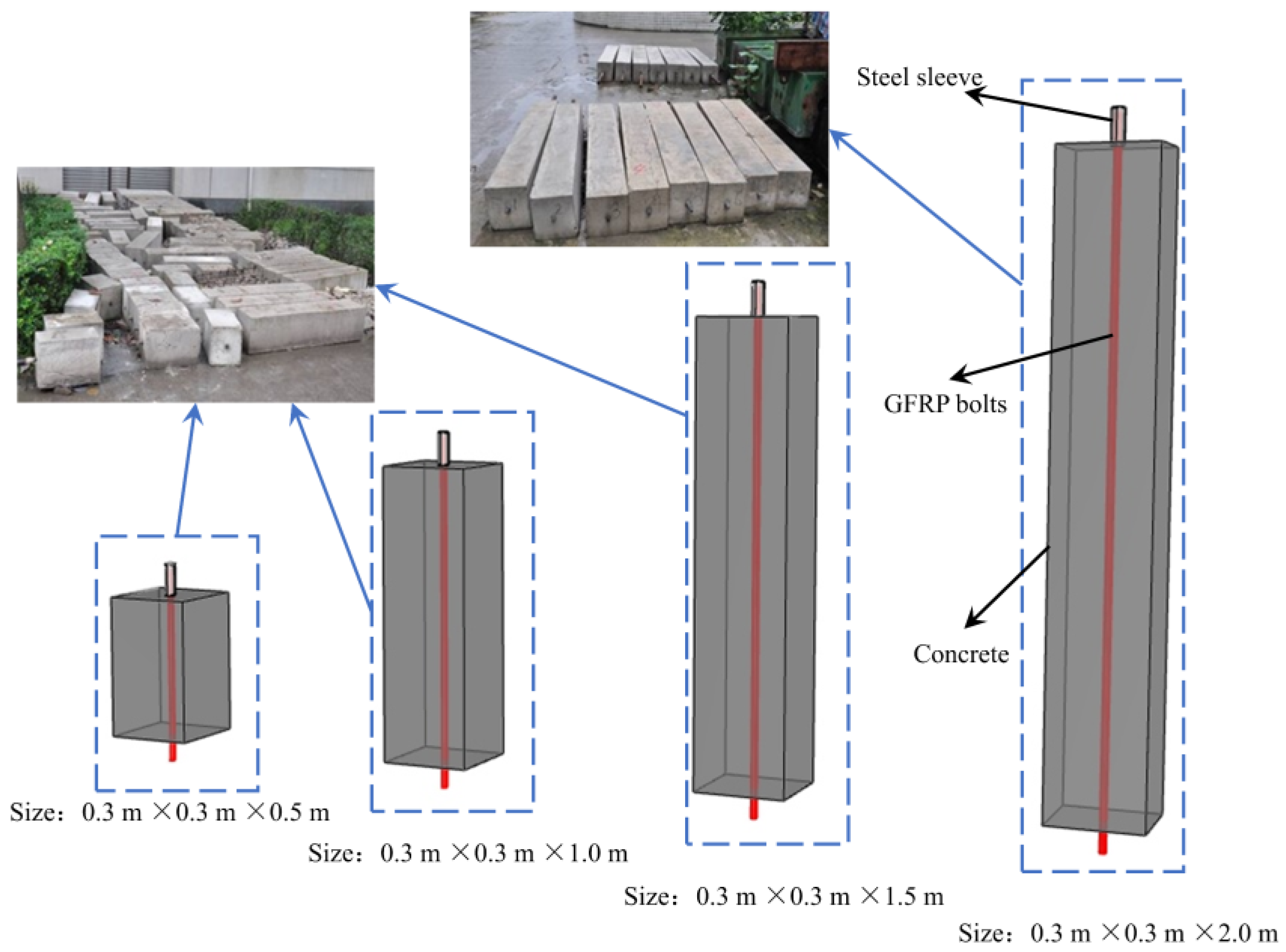
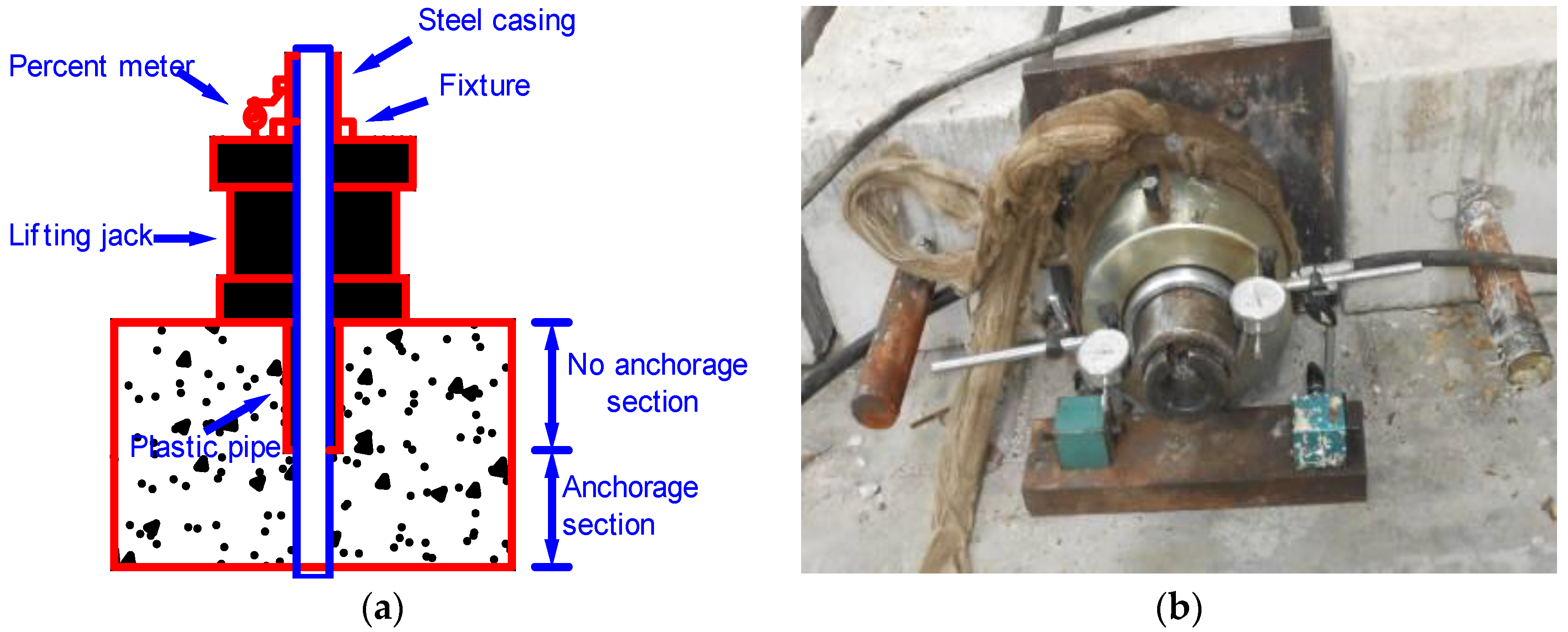
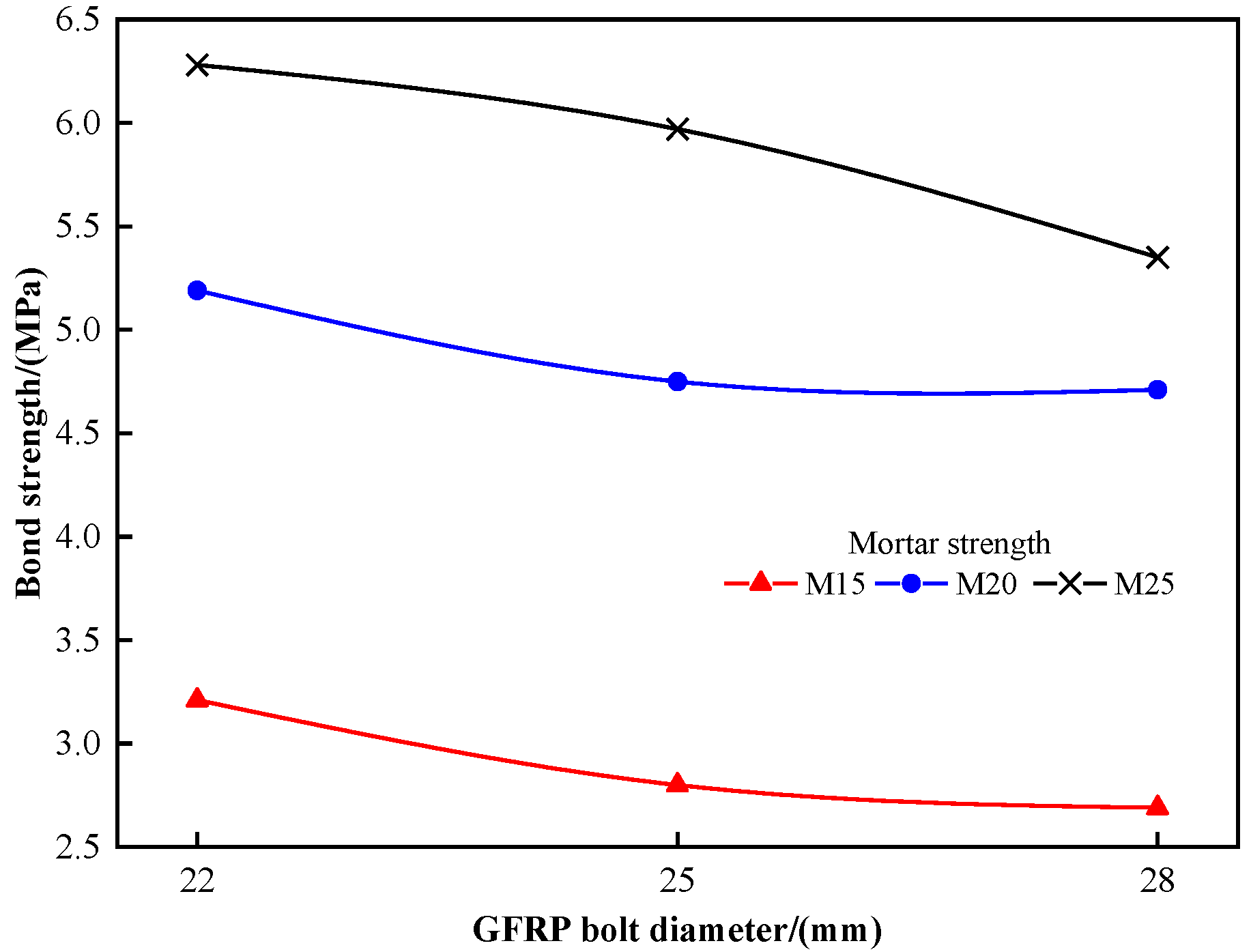
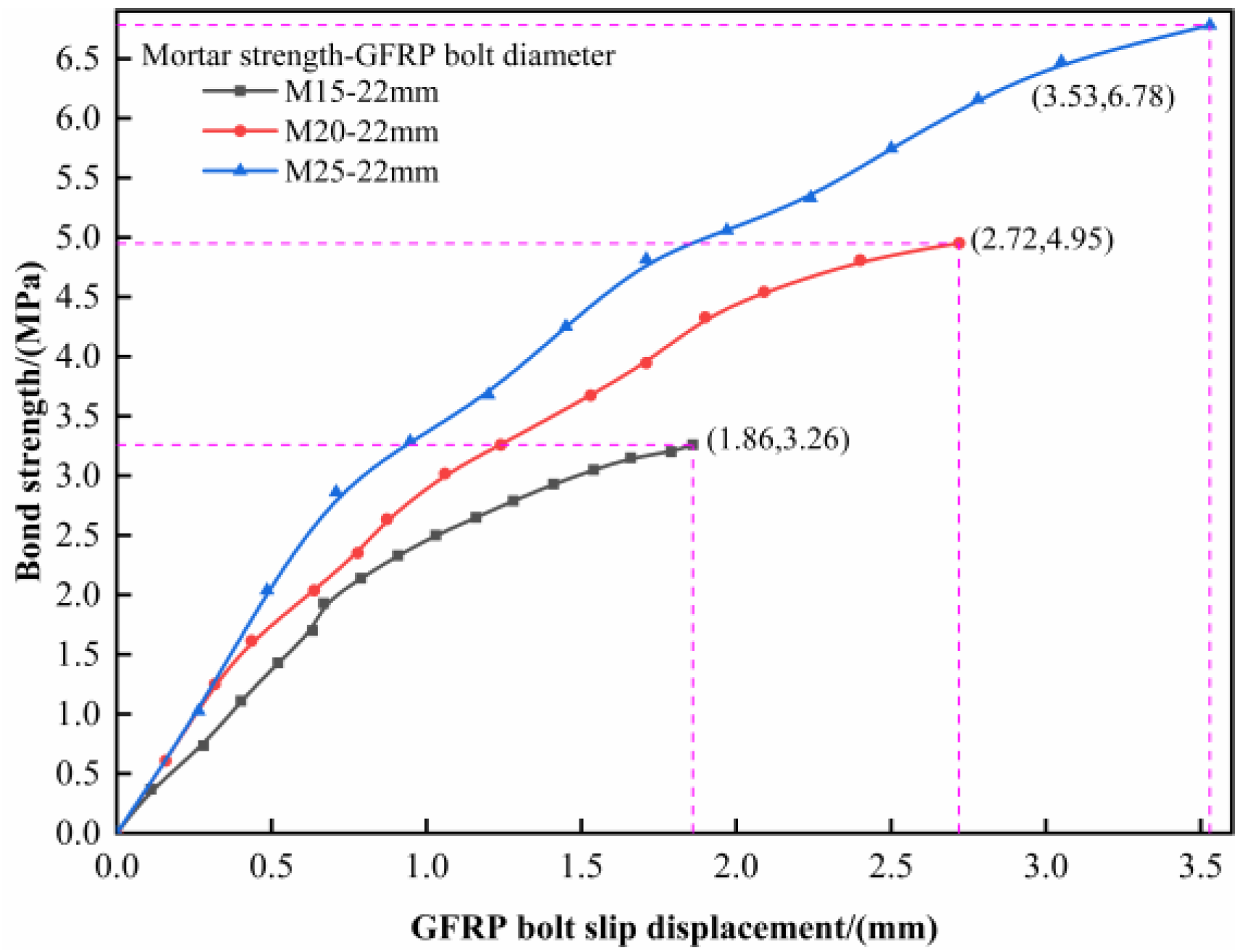

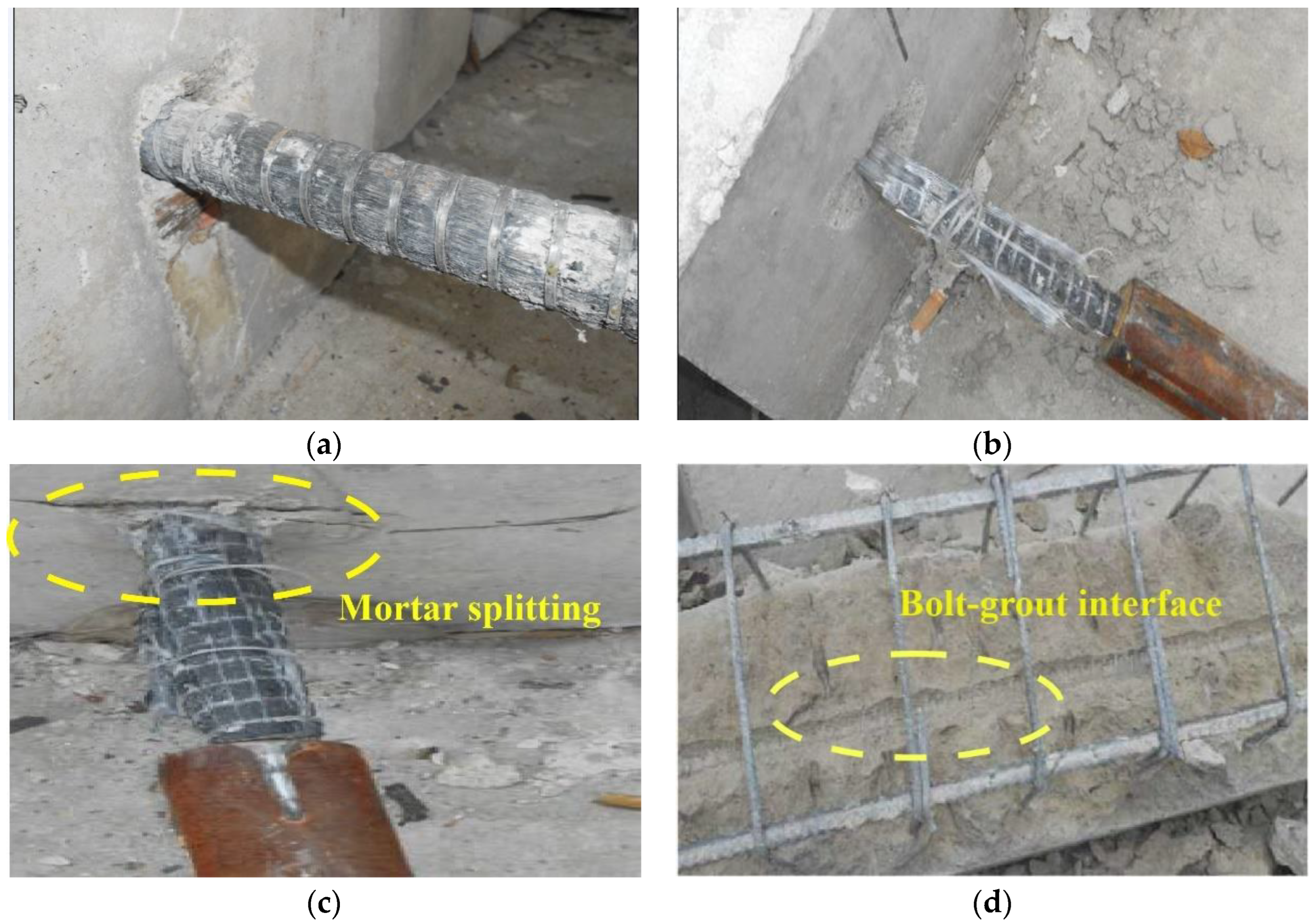
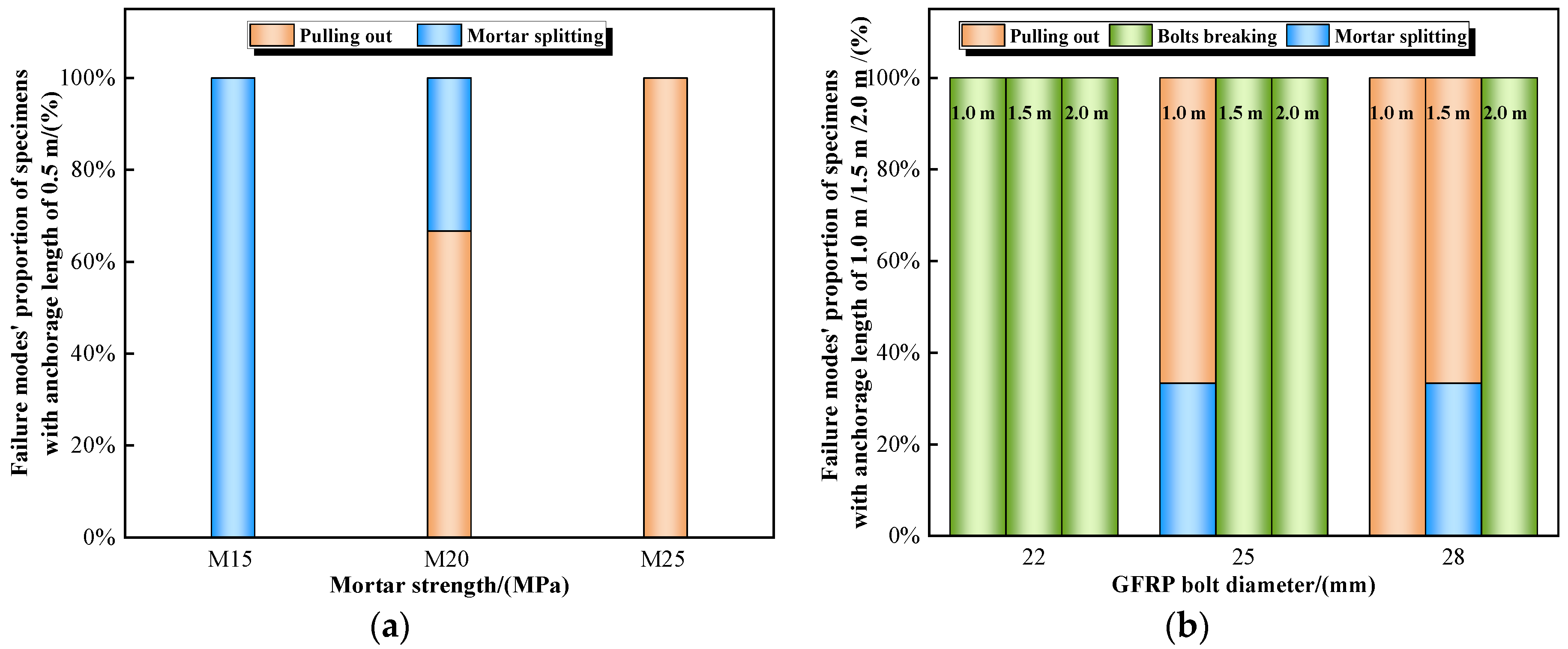

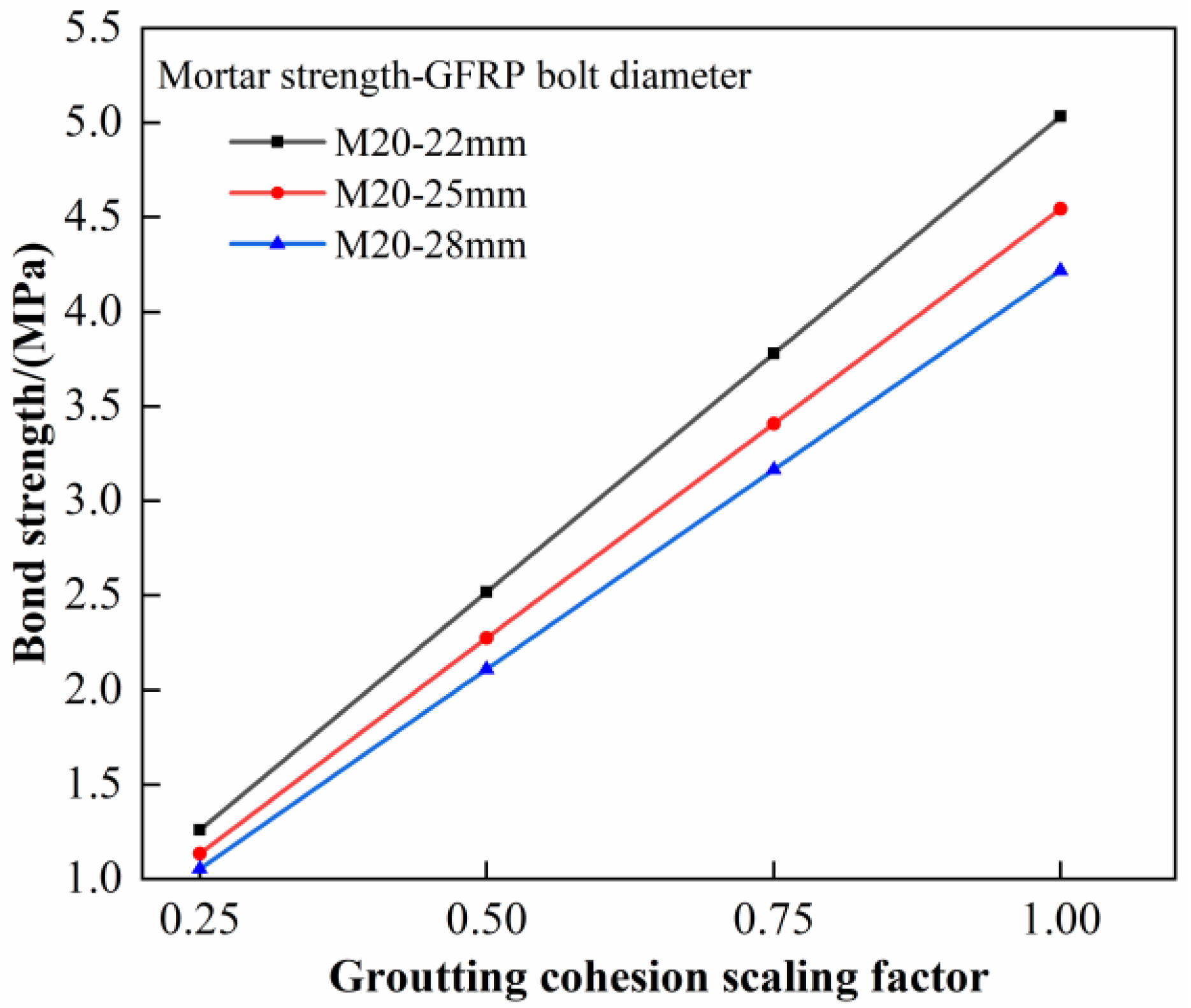

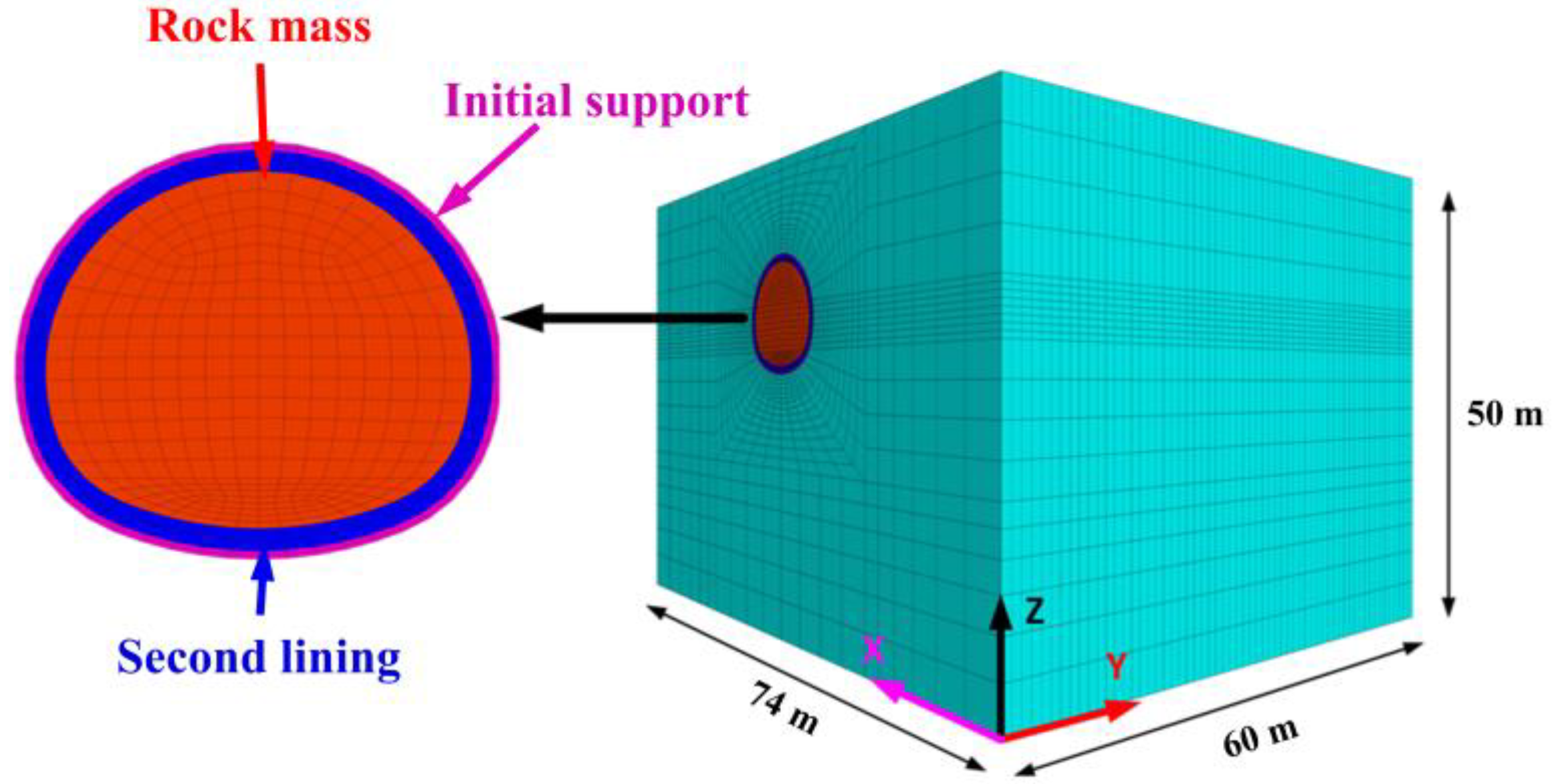

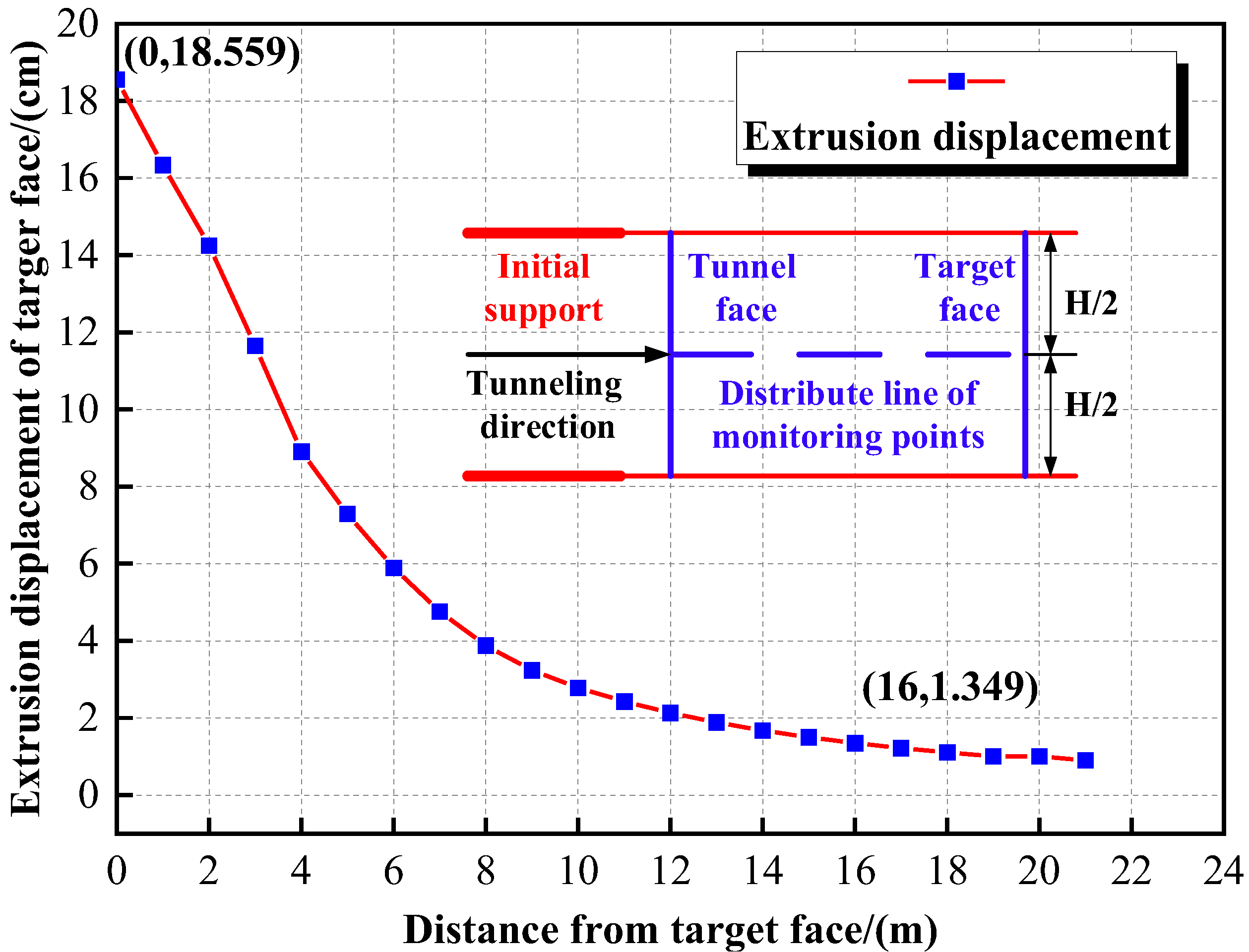
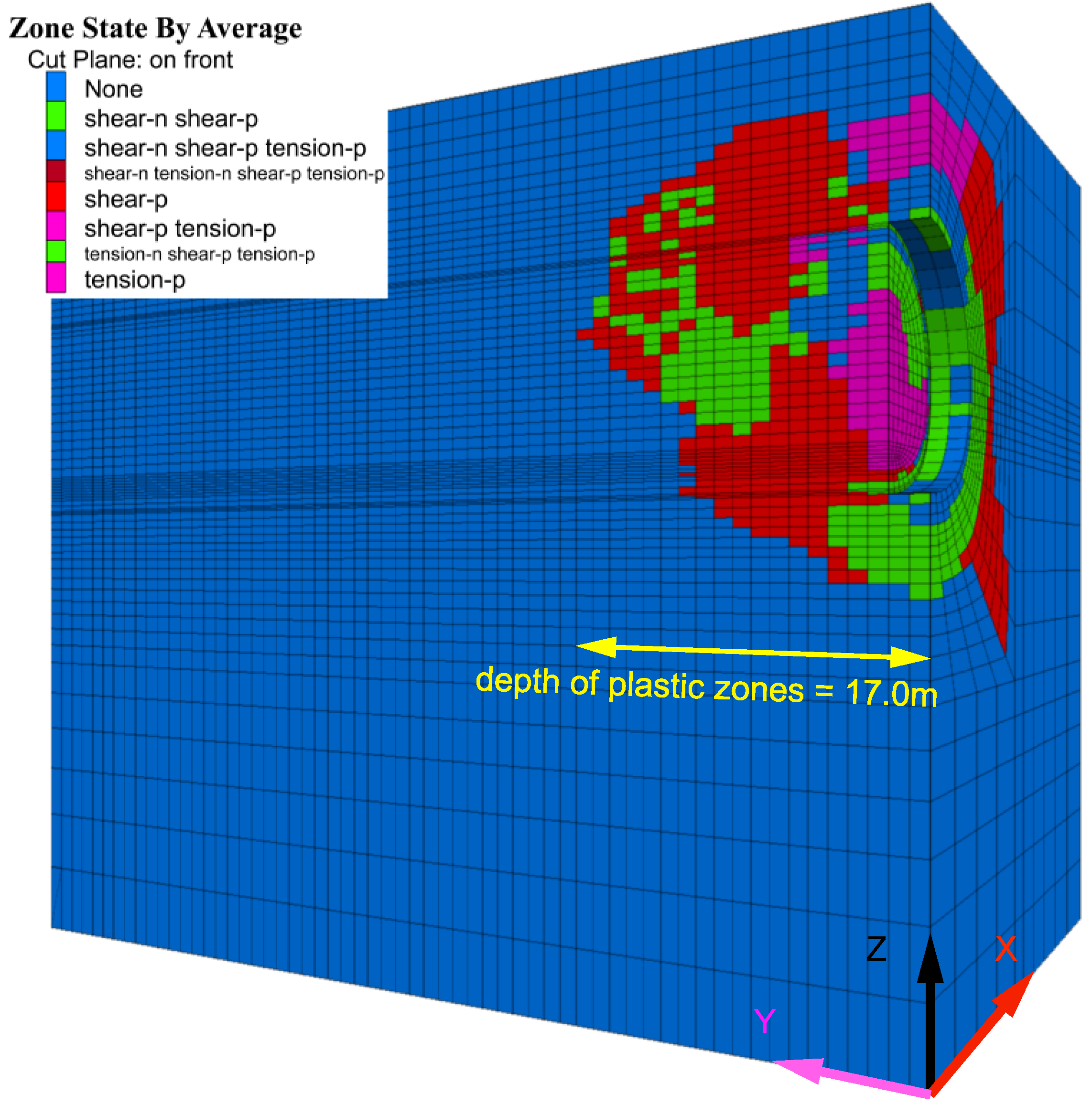
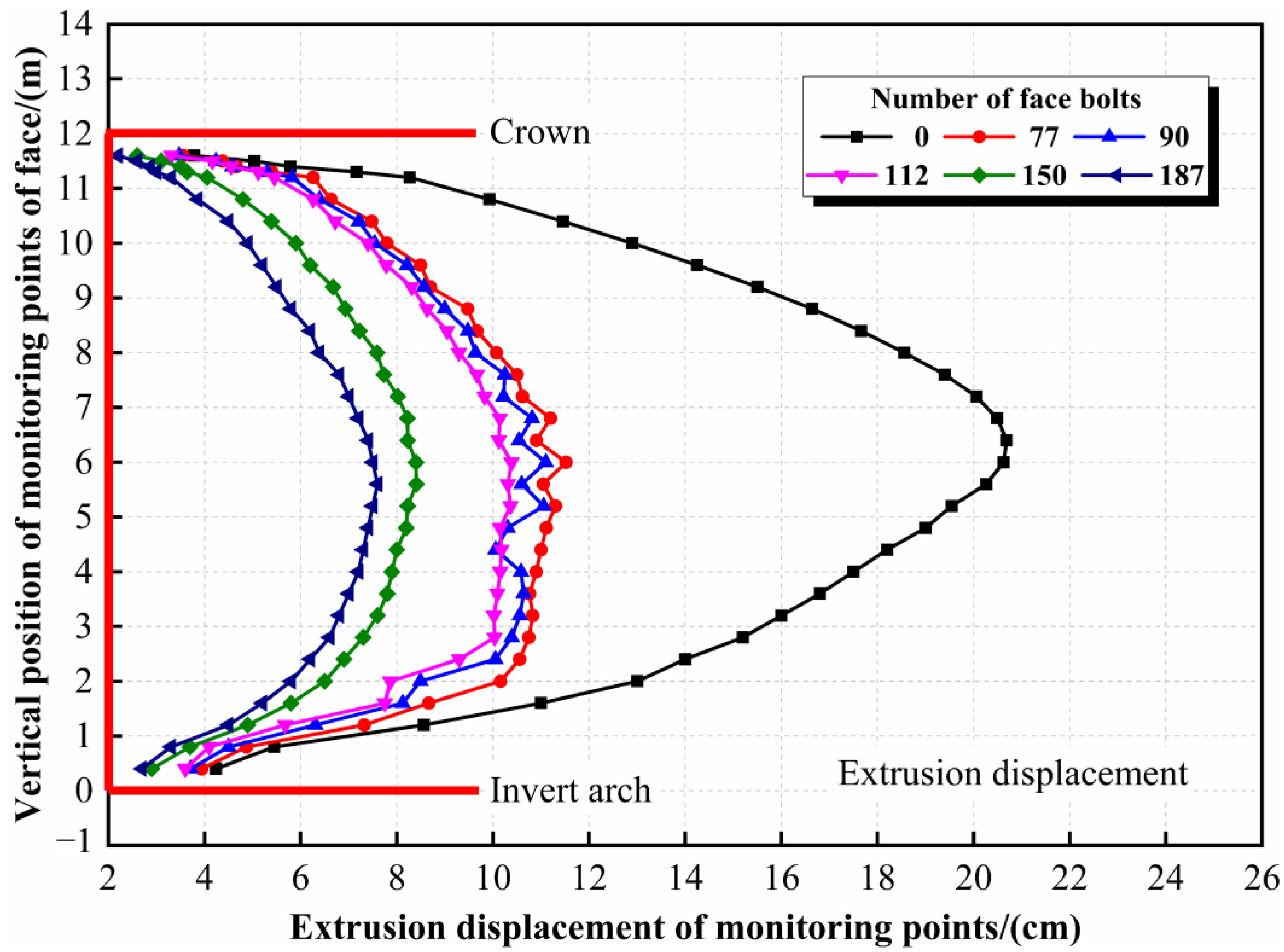


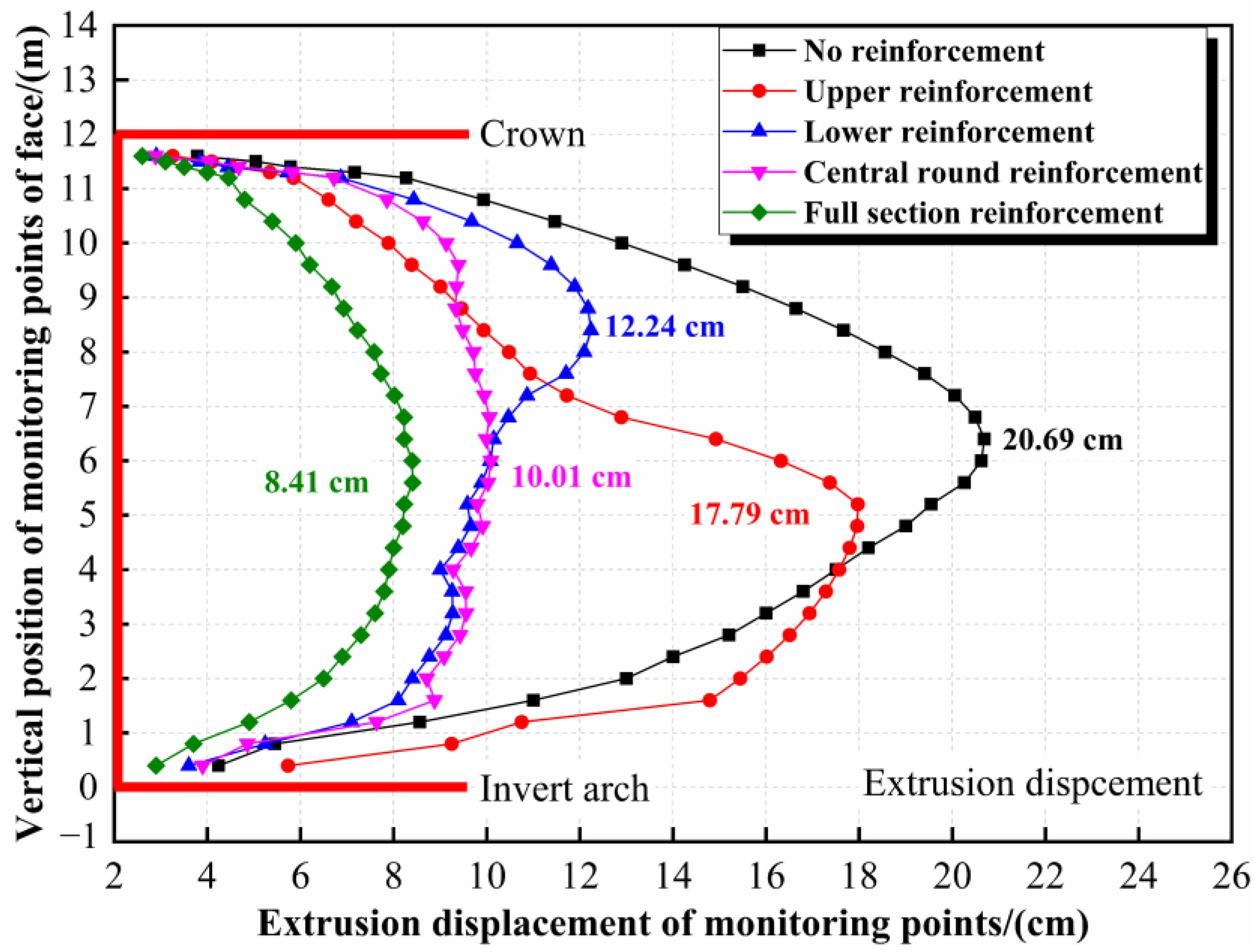
| Anchorage Length (m) | Mortar Strength (MPa) | Number of Specimens | Total | ||
|---|---|---|---|---|---|
| Φ22 | Φ25 | Φ28 | |||
| 0.5 | M15 | 3 | 3 | 3 | 9 |
| M20 | 3 | 3 | 3 | 9 | |
| M25 | 3 | 3 | 3 | 9 | |
| 1.0 | M20 | 3 | 3 | 3 | 9 |
| 1.5 | 3 | 3 | 3 | 9 | |
| 2.0 | 3 | 3 | 3 | 9 | |
| Total | 18 | 18 | 18 | 54 | |
| Diameter (mm) | Effective Diameter (mm) | Tensile Strength (MPa) | Young’s Modulus (GPa) | Design Value of Tensile Strength (MPa) |
|---|---|---|---|---|
| 22 | 21.8 | 634.2 | 45.3 | 443.4 |
| 25 | 24.8 | 671.2 | 43.3 | 469.8 |
| 28 | 27.7 | 692.1 | 41.2 | 484.5 |
| Mortar Strength (MPa) | Cement (kg) | Sand (kg) | Water-Cement Ratio | Water (kg) |
|---|---|---|---|---|
| 15 | 310 | 1500 | 0.84 | 260 |
| 20 | 710 | 1219 | 0.38 | 271 |
| 25 | 898 | 898 | 0.45 | 404 |
| Anchorage Length (m) | Mortar Strength (MPa) | GFRP Bars’ Diameter (mm) | Mean Ultimate Pull-Out Resistance (kN) | Mean Bond Strength (MPa) |
|---|---|---|---|---|
| 0.5 | M15 | 22 | 111.02 | 3.21 |
| 25 | 109.91 | 2.80 | ||
| 28 | 118.33 | 2.69 | ||
| M20 | 22 | 179.26 | 5.19 | |
| 25 | 186.71 | 4.75 | ||
| 28 | 207.30 | 4.71 | ||
| M25 | 22 | 217.04 | 6.28 | |
| 25 | 234.47 | 5.97 | ||
| 28 | 235.32 | 5.35 | ||
| 1.0 | M20 | 22 | 266.14 | 3.85 |
| 25 | 277.08 | 3.53 | ||
| 28 | 282.81 | 3.22 | ||
| 1.5 | 22 | 289.45 | 2.79 | |
| 25 | 373.82 | 3.17 | ||
| 28 | 391.68 | 2.97 | ||
| 2.0 | 22 | 265.45 | 1.92 | |
| 25 | 402.34 | 2.56 | ||
| 28 | 459.12 | 2.61 |
| Working Conditions | Cohesive Strength of Grouting/(kN/m) | ||
|---|---|---|---|
| M15–22 | 225.32 | 518.36 | 2.3 |
| M15–25 | 190.07 | 589.05 | 3.1 |
| M15–28 | 184.73 | 659.73 | 3.6 |
| M20–22 | 342.12 | 691.15 | 2.0 |
| M20–25 | 357.36 | 785.40 | 2.2 |
| M20–28 | 371.21 | 879.65 | 2.4 |
| M25–22 | 468.60 | 863.94 | 1.8 |
| M25–25 | 487.73 | 981.75 | 2.0 |
| M25–28 | 436.30 | 1099.56 | 2.5 |
| Working Conditions | |||||
|---|---|---|---|---|---|
| 0.25 | 0.50 | 0.75 | 1.00 | ||
| M20–22 | 85.53 | 171.06 | 256.59 | 342.12 | 776 |
| M20–25 | 89.34 | 178.68 | 268.02 | 357.36 | 889 |
| M20–28 | 92.80 | 185.61 | 278.41 | 371.21 | 1020 |
| Young’s Modulus E (GPa) | Poisson Ration v | Volumetric Weight (kN/m3) | Cohesion C (MPa) | Internal Friction Angle (°) | |
|---|---|---|---|---|---|
| Surrounding rock | 0.02 | 0.40 | 18.0 | 0.04 | 8.0 |
| Initial support | 20 | 0.25 | 22.0 | — | — |
| Effective Diameter of Reinforcement d (mm) | Reinforcement Length l (m) | Design Value of Tension Strength σadm (MPa) | τadm (MPa) | As (m2) |
|---|---|---|---|---|
| 24.8 | 17 | 469.8 | 2.56 | 149.23 |
| Number of Face Bolts | 0 | 77 | 90 | 112 | 150 | 187 |
|---|---|---|---|---|---|---|
| Maximum extrusion displacement | 20.7 | 11.2 | 10.5 | 10.4 | 8.4 | 7.6 |
| Maximum displacement reduction rate | — | 45.9% | 47.8% | 49.8% | 59.4% | 63.3% |
Disclaimer/Publisher’s Note: The statements, opinions and data contained in all publications are solely those of the individual author(s) and contributor(s) and not of MDPI and/or the editor(s). MDPI and/or the editor(s) disclaim responsibility for any injury to people or property resulting from any ideas, methods, instructions or products referred to in the content. |
© 2023 by the authors. Licensee MDPI, Basel, Switzerland. This article is an open access article distributed under the terms and conditions of the Creative Commons Attribution (CC BY) license (https://creativecommons.org/licenses/by/4.0/).
Share and Cite
Li, H.; Fu, J.; Chen, B.; Zhang, X.; Zhang, Z.; Lang, L. Mechanical Properties of GFRP Bolts and Its Application in Tunnel Face Reinforcement. Materials 2023, 16, 2193. https://doi.org/10.3390/ma16062193
Li H, Fu J, Chen B, Zhang X, Zhang Z, Lang L. Mechanical Properties of GFRP Bolts and Its Application in Tunnel Face Reinforcement. Materials. 2023; 16(6):2193. https://doi.org/10.3390/ma16062193
Chicago/Turabian StyleLi, Huayun, Junfu Fu, Bingguang Chen, Xin Zhang, Zhiqiang Zhang, and Lin Lang. 2023. "Mechanical Properties of GFRP Bolts and Its Application in Tunnel Face Reinforcement" Materials 16, no. 6: 2193. https://doi.org/10.3390/ma16062193





